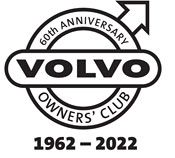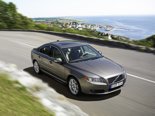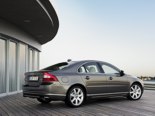

Photographs can be seen in our Volvo Gallery
All new Volvo S80. Performance and driving comfort in the premium class
27 February 2006
• The world’s most compact V8
engine
• All new, transverse, six-cylinder, in-line engine
• Energy-efficient, in-house manufactured turbo diesel
• Five-cylinder light-pressure turbo petrol engine
With the all new Volvo S80, Volvo Cars is further reinforcing its position in the prestigious premium car segment.
A powerful, impressive-sounding V8 engine and an entirely new, extremely compact in-line six offer top-class performance and driving comfort.
The diesel alternative, Volvo’s in-house manufactured five-cylinder D5 engine offers an extraordinary combination of performance, drivability and environmental efficiency.
Like Volvo’s other car models, the Volvo S80 is designed for a transverse engine and front-wheel drive or All Wheel Drive. A transverse engine provides useful space for deformation in the engine compartment in the event of a collision, and also helps create a spacious passenger compartment. With a generous measure of creativity and advanced engine technology, Volvo has also succeeded in fitting the larger six-cylinder and V8 engines transversely.
First Volvo sedan with V8 power
The all new Volvo S80 is the first of Volvo’s sedan models to be
powered by the compact, transversely mounted V8 engine that was first launched
in the Volvo XC90. A unique design with a slim 60-degree angle between the
cylinder banks makes this an extremely compact V8 engine. And by reversing the
traditional offset of the cylinders and placing the left row ahead of the right,
the engine has the optimum shape for fitting into the car’s body structure.
Furthermore, the entire engine is made of aluminium, which results in low weight
and good fuel economy. A counter-rotating balancer shaft contributes to the
steady rhythm of the engine.
The V8 engine is immensely powerful. A large displacement of 4.4 litres, power output of 232 kW (315 PS) and no less than 440 Nm of torque provide the power and high-speed performance needed for particularly enthusiastic driving. There’s a massive 370 Nm of torque available around 2000 r/min – the most common rev range in everyday driving.
"With a powerful V8 in the S80, we can reach out to the most discerning of customers," says Derek Crabb, Vice President Powertrain at Volvo Cars. "In the prestige class, there are many buyers who would never consider any other engine alternative."
Furthermore, this is one of the cleanest V8 engines on the market. Four catalytic converters – two of which are positioned close to the engine – and a highly advanced engine management system contribute to quick start-up of the filtration process and reduce exhaust emissions to a minimum (satisfies ULEV II and Euro 4 requirements).
In order to improve fuel economy still further, the V8 engine has been equipped with variable camshaft timing as well as a variable intake system.
New six-cylinder in-line engine – two
engines in one
Together with the all new Volvo S80, Volvo Cars is launching an entirely new
high-efficiency six-cylinder in-line engine. Its main structure is made of
aluminium and has a larger displacement than its predecessor – 3.2 litres
compared with the previous 2.9. Power output is 175 kW (238 PS) and torque is
320 Nm, corresponding to increases of 31 kW and 40 Nm respectively.
The new in-line engine features an advanced valvetrain and a variable intake system that contribute to both good performance and high fuel efficiency. Several innovative solutions have also made it possible to build the engine within extremely compact dimensions.
The valvetrain features VCT (Variable Cam Timing) and CPS (Cam Profile Switching) on the inlet side – two key elements in providing the engine with excellent driveability and flexibility.
With CPS (Cam Profile Switching) the intake valves can be lifted to two different heights depending on the engine speed and load.
In normal driving, with normal throttle opening and low engine revs, fuel consumption is modest at the same time that torque is sufficient to provide good driveability.
In more enthusiastic driving involving full throttle opening and high engine revs, the engine responds instantly to the accelerator and provides a massive thrust of power, both at low and at high speeds.
"In principle, Cam Profile Switching creates two engines in one," explains Derek Crabb. "We can unite widely differing demands on one and the same engine and easily meet the requirements of customers with entirely different wishes. Our focus is just as much on satisfying customers who prioritise performance as those who are more interested in driving comfort and fuel economy."
VIS (Variable Intake System) consists of two throttle flap valves which adjust the intake manifold volume to suit the current driving situation.
"With VIS we can exploit the engine’s capacity to the maximum and extract the maximum possible power throughout the entire rev range," says Derek Crabb.
Like the V8 engine, the six-cylinder engine is mated to a six-speed automatic Geartronic transmission. It is engineered to handle the immense power produced by these engines. Geartronic allows the driver to change gears manually.
Compact format contributes to impressive
collision safety
Despite the engine’s 3.2 litre displacement, it has extremely
compact exterior dimensions. The complete engine package is only 3 millimetres
longer than Volvo’s five-cylinder engine. The total engine length is 625
millimetres.
"A compact format is a matter of safety," explains Derek Crabb. "It is particularly important that the engine takes up minimal space longitudinally in the vehicle. The way we see it, a compact transversely installed engine is the best way of reducing the risk of intrusion into the passenger compartment in a collision."
The engine’s compact format has been achieved by locating the ancillaries, such as the Power Assisted Steering Pump and Air Conditioning Compressor, behind the engine in the space above the gearbox. Consequently, there is no front-end drive of the ancillaries. Instead they are driven via gears by the rear end of the crankshaft. This engineering solution is known as READ – Rear End Ancillary Drive. The alternator is direct-driven and installed on the engine block. This solution means that the entire engine and transmission package takes up minimum space, particularly in the car’s longitudinal direction.
By designing the drive system in the form of a small gearbox with an intermediate shaft inside the driveshaft – known as a Shaft In Shaft design – it was possible to ensure a very short package. The two shafts are driven by different gears that give them different speeds (one speed for camshaft drive and one for the ancillaries).
"It’s a particularly compact solution that is the result of highly advanced development work," explains Derek Crabb.
The vibration damper, which compensates for vibration in the six-cylinder engine’s relatively long crankshaft, has also been integrated into the engine block.
"All told, the new six-cylinder engine offers a premium experience in every respect," comments Derek Crabb. "This applies to its performance and fuel efficiency as well as its driving comfort and the sound of the engine. The fact that the engine’s design also helps enhance safety isn’t something the customer usually thinks about but it is naturally a key element in Volvo’s product concept," he adds.
Energy-efficient turbo diesel of the new D5
generation
The all new Volvo S80 can also be specified with Volvo’s in-house manufactured
five-cylinder D5 diesel engine. It is the recently launched second D5
generation, a very powerful and responsive turbodiesel which is provided in two
versions. The most powerful engine delivers a huge 400 Nm of torque, and it is
available across a very wide rev range.
Compared with the previous generation, the new D5 engine has been improved and refined extensively with a new electronically controlled turbo charger, refined multi-throttle injection technology and a very powerful engine management system. The improvements have resulted in an entirely new driving experience with considerably higher performance and improved drivability. At the same time, there has been a sharp reduction in emissions.
A particle filter requiring no service is fitted as standard, making the D5 a very environmentally efficient alternative.
"The D5 will be perceived as a lively petrol engine, only more powerful and more environmentally efficient," says Derek Crabb.
Five-cylinder light-pressure turbo engine
A five-cylinder petrol engine is also available as an alternative for the all
new Volvo S80. This engine has a light-pressure turbocharger and a power output
of 147 kW (200 PS), with 300 Nm of torque. The engine is very compact, partly
because the turbocharger has been integrated into the exhaust manifold. It is
made of high-quality steel that withstands high exhaust temperatures and
contributes to effective combustion and low exhaust emissions.
Engine range. Petrol
| Engine | Configuration | Power kW/PS | Torque Nm |
| 4.4 V8 | V8 | 232/315 | 440 |
| 3.2 I6 | I6 | 175/238 | 320 |
| 2.5 I5 | I5 | 147/200 | 300 |
Engine range. Diesel
| Engine | Configuration | Power kW/PS | Torque Nm |
| D5 | I5 | 136/185 | 400 |
| 2.4D | I5 | 120/163 | 340 |
Click to enlarge
Legal | Privacy | Contact Us | Search | Site Map
Volvo Owners' Club Limited® 1962-2024




